Physical Address
304 North Cardinal St.
Dorchester Center, MA 02124
Superior labrum anterior-posterior (SLAP) tears are a cause of shoulder pain often found in overhead athletes, and less often in patients who have suffered a traumatic injury.
SLAP tears are a detachment of the superior glenoid labrum (typically from 11 to 10 o’clock) with or without involvement of the long head of the biceps (LHBT) tendon anchor (where the LHBT originates at the supraglenoid tubercle in the 12 o’clock position) ( Fig. 50.1 ).
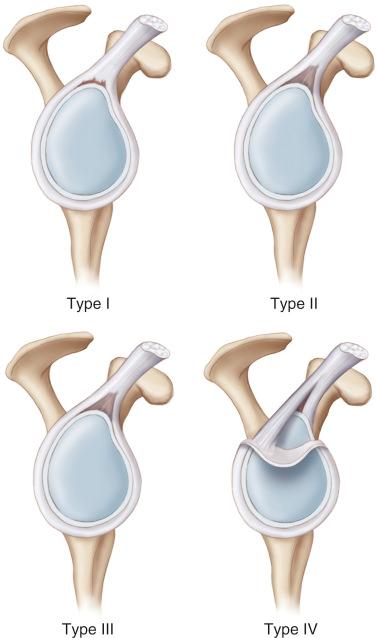
Type II SLAP tears (detachment of the superior labrum and LHBT insertion from the supraglenoid tubercle) are the most common, and arthroscopic repair is the most widely accepted treatment, particularly in younger individuals.
Provencher et al. (2013) found that in a subset of 179 patients who underwent arthroscopic SLAP repair, 66 (36.8%) were deemed to have a failed repair, mostly in those over the age of 38 years.
Failed SLAP repairs can be defined as postoperative pain and/or stiffness (not associated with concomitant pathology) that does not resolve with nonsurgical measures.
There are several etiological factors that lead to failed SLAP repair including overconstraint, inadequate labral blood supply for labrum healing, improper postoperative mobilization protocols, and possible overtreatment.
Initial management of failed SLAP repairs consist of physical therapy, nonsteroidal antiinflammatories, and activity modification.
Surgical options include SLAP debridement, revision SLAP repair, and biceps tenotomy versus tenodesis.
Once the diagnosis of a failed SLAP repair has been made and the patient has exhausted nonoperative options, surgical alternatives including SLAP debridement, revision SLAP repair, and biceps tenotomy versus tenodesis should be considered.
SLAP debridement should be considered for failed type I lesions without prior anchor repair and without instability of the superior labrum during diagnostic arthroscopy. In this case, the surgeon gently debrides the superior labrum’s frayed edges.
Revision SLAP repair should be considered in young, active patients less than 35 years old with isolated type 2 SLAP tear findings. Alternatively, it can be considered for middle-aged patients who are opposed to LHBT tenotomy or tenodesis.
Aside from removing all preexisting hardware and sutures (if possible), the revision procedure is otherwise very similar to the index SLAP repair in terms of appropriate fixation points, and abrading superior glenoid bone to stimulate healing.
Biceps tenotomy is primarily considered for failed SLAP repair in less active individuals, generally age 65 years or older, who are not concerned about potential cosmesis or functional limitations. In this case, the LHBT is cut arthroscopically at the biceps labral junction and not reattached. The LHBT glenoid stump is then debrided to leave a smooth labral edge.
Biceps tenodesis is favored for management of failed SLAP repair in most patients, primarily young patients with LHBT pathology. The LHBT can be tenodesed at multiple locations including: 1) the top of the biceps groove; 2) the suprapectoral region; 3) the subpectoral region.
Neri et al. and Provencher et al. have identified increased age, particularly greater than 36 years, and overhead athletes as demographics that may be at higher risk of failure after arthroscopic type II SLAP repair.
The most common complaints following arthroscopic SLAP repair are postoperative stiffness, pain, and mechanical symptoms—all of which can lead to failure.
A failed repair is characterized by the above symptoms (not associated with concomitant pathology) that do not resolve without surgery. These symptoms either never resolve after the index surgery or resolve postoperatively and return at a later date.
Symptoms attributed to a failed SLAP repair may be caused by a variety of factors. Three of the most common sources of postoperative stiffness, pain, and mechanical symptoms include: unintentional restriction of physiological biceps excursion, nonanatomic biceps anchor reduction, and failure of the labrum to heal to the superior glenoid. In addition, persistent pain, despite appropriate healing, can occur, as the intraarticular portion of the long head of the biceps tendon contains sensory and sympathetic fibers, which, if irritated, will cause pain.
When a patient presents with recurrent pain, stiffness, and/or mechanical symptoms following arthroscopic SLAP repair, a comprehensive physical exam should be performed to differentiate failed SLAP repair from concomitant shoulder pathology. Note that postoperative stiffness is the most common cause of pain after SLAP repair, and may resolve with formal physical therapy and/or injections.
In addition to passive/active range of motion and strength testing, provocative testing should be performed. If a failed SLAP repair is present, patients should be symptomatic with the same provocative tests used to diagnose a primary SLAP tear.
The O’Brien, or active compression test, is a common test for superior labral pathology. The patient forward flexes the arm to 90 degrees, adducts the arm 10–15 degrees across their body, and maximally internally rotates the shoulder (points the thumb to the floor). An inferiorly directed force is applied to the arm while the patient resists. The patient’s shoulder is then moved to a position of maximum external rotation, and the downward force is repeated. A positive test is indicated by pain or painful clicking in shoulder internal rotation and less or no pain in external rotation ( Fig. 50.2 ).
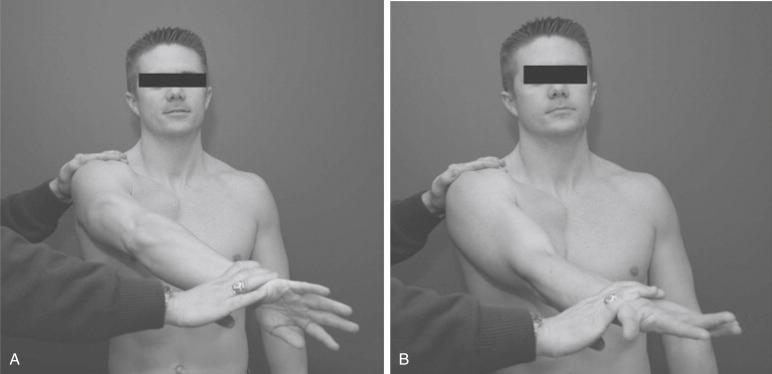
The crank test can also be used to assess superior labrum pathology. The arm is elevated to 160 degrees in the scapular plane, and axial compression is applied while the examiner rotates the shoulder through full internal and external rotation. A positive test is indicated by pain, an audible or palpable click, or apprehension ( Fig. 50.3 ).
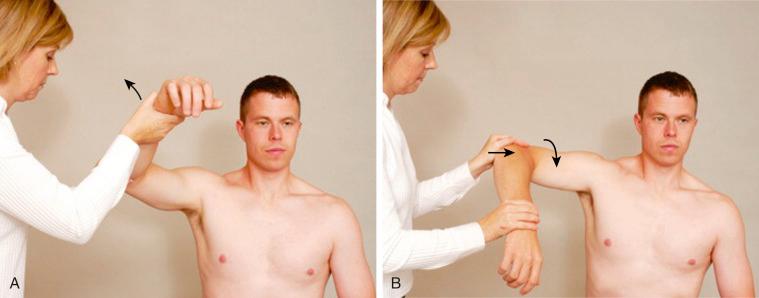
The anterior slide test is used to help identify superior labral pathology. The patient’s hands are placed on the hips with the thumbs positioned posteriorly. The examiner stands behind the patient and places one hand on the superior shoulder and the other hand on the patient’s elbow. The examiner places a slightly anterior and superior force on the shoulder to load the biceps anchor. A positive test is indicated by pain in the anterior shoulder or a palpable click in the same region ( Fig. 50.4 ).
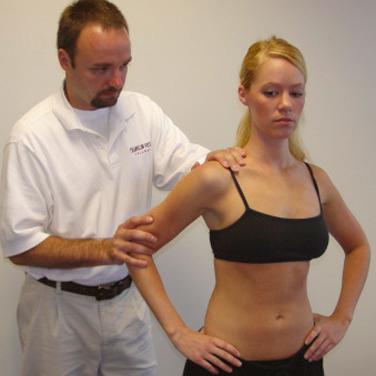
Patients presenting with failed SLAP repair may also exhibit pain with traditional biceps provocation maneuvers including the Speed and Yergason tests.
Given the complexity of making a diagnosis of failed SLAP repair on exam, differential corticosteroid and/or local anesthetic injections may also be a useful adjunct in the diagnostic workup. For instance, a clinician may provide a diagnostic and potentially therapeutic injection in the subacromial space in one visit, then one in the glenohumeral joint in a subsequent visit, and another in the acromioclavicular joint during another visit. This is particularly helpful if their pain is localized to any of these areas. Response to an injection may help localize symptoms and may identify or rule out concomitant pathology.
Though a failed repair may be suspected, physicians should be cautious of presuming such a diagnosis; in a study of 22 patients (24 shoulders) with persistent pain after SLAP repair, Weber et al. identified a true anatomically failed SLAP repair arthroscopically in only 7 of 24 shoulders. Other pathology such as rotator cuff tears and tendinopathy should be considered.
Plain radiographs (AP, axillary lateral and outlet views) should be obtained in order to assess for osseous abnormalities of the shoulder including degenerative changes, fractures, loose bodies, calcific tendinosis, and any other pathologic process that may cause the patient’s pain. Furthermore, areas of prior fixation should be evaluated. Radiopaque implants and areas of radiolucency that may indicate the location of radiolucent implants should be evaluated, as these areas of prior fixation could also contribute to the patient’s pain.
Magnetic resonance imaging (MRI) can be useful in order to assess the bicipital groove, biceps tendon, fluid, inflammation, tendon tears, and can help identify other concomitant pathologies.
Magnetic resonance arthrography (MRA) is the study of choice in evaluating failed SLAP repairs ( Fig. 50.5 ). Although all image series should be reviewed, focus should be on the coronal views at the superior labrum to asses any contrast extending into a linear or complex tear cleft within the labrum. Absence, truncation, or fragmentation of the labrum, or displacement of the labrum from its expected anatomic location all suggest recurrent labral pathology. Probyn et al. (2007) found that in patients with index SLAP repairs, MRA was 93.8% sensitive, and 85.7% specific, with a positive predictive value (PPV) of 83.3%, a negative predictive value (NPV) of 94.7% and accuracy of 89.2% for the diagnosis of recurrent superior labral tear after initial repair.
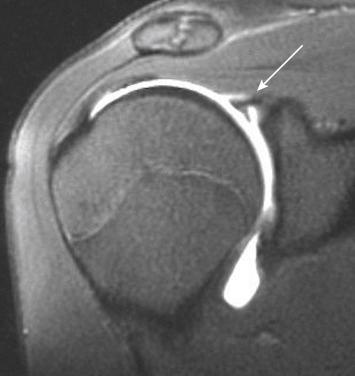
If magnetic resonance imaging is not an option, for example in patients with a pacemaker, certain types of vascular clips, or other loose metal debris, CT arthrography may be the next best imaging modality, although with increased radiation exposure ( Fig. 50.6 ).
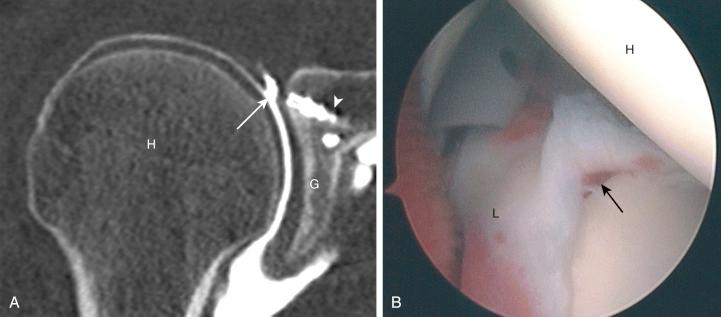
Treatment options for failed SLAP repair include: (1) nonoperative management, including physical therapy and strengthening programs, nonsteroidal anti-inflammatories, and activity modification; (2) Operative management, including SLAP debridement, revision SLAP repair, biceps tenodesis with or without revision SLAP repair, and biceps tenotomy.
Physical therapy and strengthening programs should emphasize scapular stabilization exercises and posterior capsular stretching.
Nonsurgical measures must emphasize pain control; a subacromial cortisone injection followed by a fluoroscopy-guided intraarticular injection of the biceps tendon should be considered. Beyond potentially providing therapeutic relief, such injections can be diagnostic.
Although it is appropriate to pursue nonsurgical measures before pursuing surgical options, Katz et al. reported that 71% of patients with recurrent pain and/or symptoms following SLAP repair are unsatisfied with nonoperative management.
Despite this, Edwards et al. (2010) found that those with successful nonoperative treatment had significant improvements in pain, function, and quality of life. Return to sports for this group was comparable to patients with successful surgical treatment.
Once a diagnosis of failed SLAP repair is made and the patient has failed nonoperative management, the following surgical options should be considered: SLAP debridement, revision SLAP repair, biceps tenotomy, or biceps tenodesis with or without revision SLAP repair.
Revision procedures after primary SLAP repair generally do poorly, particularly in overhead athletes. However, revision SLAP repair may be considered in young, active patients less than 35 years old without any pathology of the LHBT.
Biceps tenotomy is primarily considered for failed SLAP repair in less active individuals, generally age 65 years or older, who are not concerned about potential cosmesis or functional limitations.
Biceps tenodesis should be considered for management of most failed type II SLAP.
Boileau et al. (2009) found a significantly higher satisfaction and return-to-sports rate in a cohort of 15 consecutive patients undergoing biceps tenodesis for isolated type II SLAP lesions, compared to a group of 10 patients undergoing SLAP repair.
Because of its inability to completely restore translational stability, biceps tenodesis may be less effective in overhead-throwing athletes.
Although patients generally have better outcomes with operative intervention compared to nonoperative, 32% will continue to have a suboptimal result.
An understanding of arthroscopic shoulder anatomy including the rotator interval, glenoid labrum, and origin of the LHBT are essential in identifying failed SLAP repairs.
The LHBT arises from the superior glenoid labrum, travels distally in the bicipital grove, and inserts on the radial tuberosity. The labrum, from which the LHBT arises, is a triangular rim of fibrocartilage encasing the glenoid fossa and deepens the joint by an average of 9 mm in the superior-inferior direction and 5 mm in the anteroposterior dimension.
Arthroscopically, it is important to visualize the rotator interval comprised of the coracohumeral ligament (CHL), superior glenohumeral ligament (SGHL), supraspinatus (SS), LHBT, and subscapularis (SSc). As seen in Fig. 50.7A , patients with failed SLAP repair almost always have some degree of rotator interval synovitis, scarring of the LHBT to the capsule, and superior capsulitis.
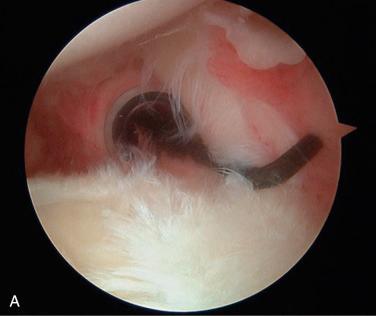
The superior glenoid, labrum, and origin of the LHBT should be carefully evaluated for SLAP repair anchor loosening, suture loosening, and unstable LHBT attachment ( Figs. 50.7B,C,D ). In order to identify loosening, structures adjacent to the suture or anchor may need to be probed.
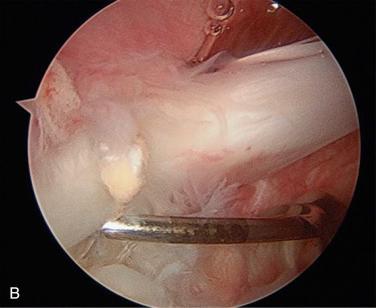
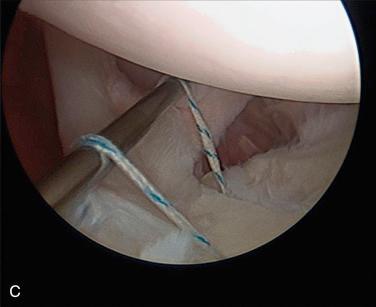
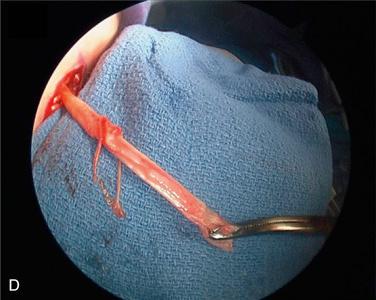
Become a Clinical Tree membership for Full access and enjoy Unlimited articles
If you are a member. Log in here